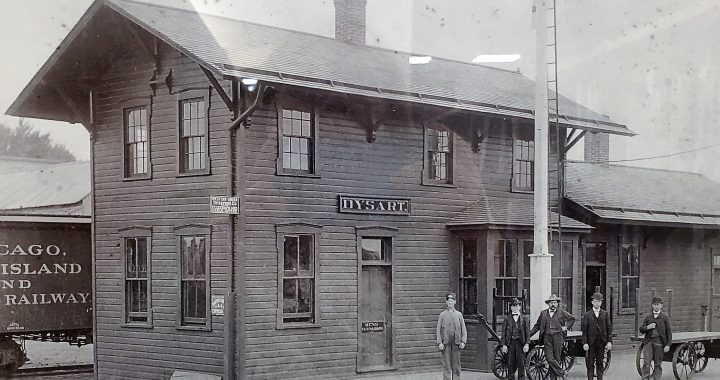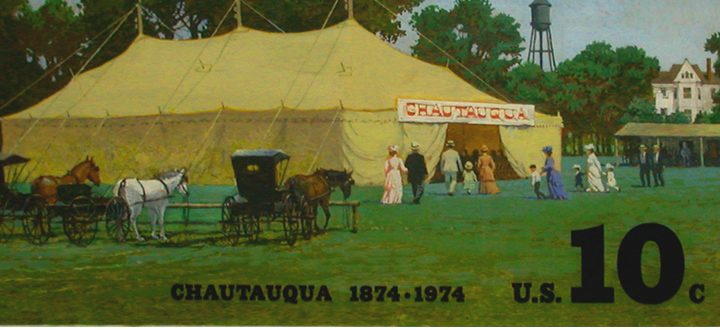July 4, 1914, Small Town Holds a Great Celebration

At 4 a.m. the sound of a light artillery brigade reverberated through this small and peaceful, but not entirely silent town. The canning factory on the northern edge of town and the adjoining cement factory produce a steady amount of noise, sometimes late into the night. Occasionally, one of the newly purchased automobiles is heard rumbling by long past the time when decent folks are asleep or it's rambunctious driver breaks the silence with the horn. But generally, 4. a.m. is a quiet, restful time reserved for dairymen and the train station manager. This Independence Day, however, the organizers of the day's event have determined that a cannon blast at 4:00 a.m. is the best way to begin a celebration of the nation's 138th birthday. There are eleven surviving civil war veterans living in town today, July 4, 1914, and for them being awoken by live artillery likely produces a different reaction than other residents, but no one considers that. These folks are three years away from the great war and all that it will teach the world about the long-term trauma of war.

Stepping Stones in Time
A glorious day full of promise and excitement awaits the people here. To say they are enthusiastic would be a complete understatement. Just one week ago 150 resident boosters spent an entire day traveling in 29 cars to many towns in the area promoting their event. Flyers have been handed out, welcoming invitations have been extended and large advertisements have been placed in local papers. Although they have hosted big celebrations in the past, this year is different. This year, July 4th is also the kick-off of their first week-long Chautauqua. A giant multi-colored tent is set up in the park in anticipation.
There are only 1000 people living here and yet they are expecting thousands of celebrants to arrive in the next few hours. The world they live in is experiencing tremendous change and they seem ready to embrace it. Their guests will arrive by horse and buggy, trains, and automobiles. Some will walk into town from their homes in the country. They will come with picnic baskets full of food and blankets to sit upon. There are two passenger trains scheduled to arrive from the east today at 9:45 a.m. and 1:21 p.m. and two from the west which will not arrive until 4:45 p.m. and 10:52 p.m. Many people arrived yesterday and found lodging where they could. There are no hotel rooms available and all through the community homes are full of out-of-town guests. The town has invited people to bring their hammocks and tents and feel free to camp overnight in the city park for the night or all week long if they wish to attend the Chautauqua. Tents are available for rent. They have promised there will be plenty of food and beverages available for sale. A special water pump station has been added to the park.
The train coming from the east arrives late and pushes events back a bit but not to the determent of the day. Among those arriving on this train is Earl Emery, a 17-year-old boy. Earl has grown into quite the young man and repaired his relationship with his father. Just three years ago he impulsively stole $75 and bought a train ticket to Alliance, Nebraska, where he was apprehended and returned home. Now he is a employed as a farmhand and is looking forward to spending some of his hard earned cash and watching his hometown team play baseball.

People flood into the main street before 9 a.m. where the M.B.A. Band is already playing. They have come, the local paper states, "to publicly express their appreciation of the liberties the Declaration of Independence has brought to America and Americans". Forty automobiles line up, ready to start the parade at 9:15. There are cash prizes at stake for the best decorated car. This along with the pride of being among the first in the area to own an automobile has spurred the participants to go all out.
The town was created to accommodate the westward expansion of the railroad. Built in the middle of a prairie; there were no rivers or creeks to be consider, no hills and even significant elevations to contend with. As a result, the whole town is a grid with every street coming to a ninety degree angle with the next. There are no curves or bends in the road except through the park and even this is slight. The distance from the main street to the park is only four blocks, so running the parade directly from the corner of Wilson and Main to the City Park would leave little room for the large crowds to get a good look. Therefore, a route has been planned that includes several streets within the city's boundaries. On their last pass through the main street the attendees are encouraged to follow along to the park for the scheduled baseball game between the Vinton Cinders and the Hiteman teams.

The crowd does not know it now, but they are witnessing the beginning of a life-long baseball career. A standout player for the Vinton Cinders, twenty-year-old Edmund John "Bing" Miller will enjoy a long career playing major league ball. He will be part of teams that win two World Series titles between 1921-1936 and then coach for another 17 years. But today, he is an ordinary guy playing minor league ball with his brother and friends in the central part of of Iowa.

Dysart Reporter
The day is hot with no sign of rain. The beverage vendors will do well. The park is crowded and will stay that way. A merry-go-round has been set up with the promise to run all day. The smell of freshly roasted nuts wafts from the peanut stand, filling the senses. Carnival games called baby and cane racks and striking machines allow an opportunity for men and women to try their luck and hopefully win a memento to take home. There is even a fortune teller set up who will most likely provide you a favorable look at your future. Those who wish to stroll back to the main street business district will find that Jessen and Clemen is offering three moving picture shows featuring nine reels playing all day starting at 10 o'clock.

Source: Bretzel Liquide
At one o'clock a large crowd gathers on the main street to enjoy the free street performances by Vaudevillian entertainers. The crowd is treated to the fascinations of the Smilette Brothers and Mora, a comedy triple bar act which combines acrobatic troupe stunts along with a clown. Murdos and Novelty Dogs follows with a group of seven acrobatic fox terriers performing amazing feats. Last is the Zeno and Zoa Comedy Act, a European contortionist group performing a hand balancing and foot juggling act. They are a marvel who have traveled extensively through the Americas and Europe.
Returning to the park, crowds gather to witness the Montana Kid who it has been advertised will ride the famous bucking broncho, Steamboat. The crowd will be disappointed when the horse refuses to buck after the first few jumps. It will be revealed later that the real Steamboat has been dead for several years, but the Montana Kid will continue to make the circuit as a cowboy, at least for a while longer.
At 2:30 the big Chautauqua tent will be thrown open and a large crowd will first hear six young men who perform under the name "The American Collegian Orchestra" play several different instruments and sing. This will be followed by a lecture from a Methodist minister named Dr. Frank E. Day who will travel throughout the Midwest giving lectures under such titles as 'Does the Hour Hand Move' and 'The Worn-Out Preacher: What is he Good For Anyway'. Eventually he will become a well-known minister in Indiana and one hundred years from now, people will still be reading his writings.

Dysart is not the only community hosting a celebration today. There are also events in Waterloo and Urbana. These have drawn so many people that the editor of the Vinton newspaper reported their town looked like it had been abandoned at midday. As the heat continues to climb, a second ballgame is played in the late afternoon where a $100 purse is won by the Vinton team. Finally, as the day begins to cool down at 6:45 p.m. the street show is repeated. and at 7:45 p.m. the orchestra provides a grand concert in the tent. The day wraps up with a much-anticipated dance at the Opera House.

Dysart Train Depot
When everything is over it will be reported that an estimated 5,000 people spent that Fourth of July day in Dysart arriving in between 250 and 300 automobiles, meaning the majority must have come by train. As it starts to grow dim, tired but happy people start leaving town at various times. About 10:00 p.m. many people leave the well-lit Opera House heading for the depot so they can catch the last train heading east which is scheduled for 10:52 p.m. For most, they are a bit less animated than they were this morning however some of the young women are almost giddy from the excitement of the day and the dancing. There is a sense of happy exhaustion among them. Tired event organizers are breathing a satisfied sigh of contended relief that the day turned out so well. Their planning has not gone unappreciated. Some are already mulling over improvements for 1915. The clear night sky helps create a feeling that the day is wonderfully complete.
As the headlight of the railroad locomotive appears to the west, the crowd of approximately 500 people start collecting their things in anticipation of boarding the train. As it draws nearer, the whistle breaks the silence of the town just as it was broken this morning by the artillery fire. It is then, at approximately 11:20 p.m. that an unimaginable tragedy strikes which will spread a pallor over this magnificent celebration and send ripples across the state for many days to come.
If you have enjoyed reading this post and would like to be notified when new articles are posted, including the conclusion to this one, please sign up at the bottom of this page!





































































































































